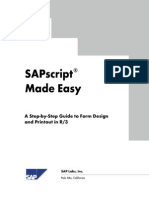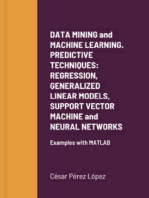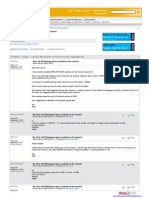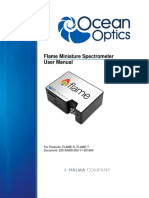0 ratings0% found this document useful (0 votes)
184 viewsSAP ABAP Object Oriented Programming Tutorials
This document provides tutorials and examples on object-oriented programming concepts in SAP ABAP. It begins with an introduction to classes in OOABAP, defining classes as templates for objects. It then provides 3 examples to demonstrate different aspects of class visibility and accessibility in ABAP OO:
1) How public, protected, and private sections of a class control accessibility of attributes and methods to the class itself, subclasses, and external users.
2) How private attributes of a superclass cannot be accessed by subclasses.
3) How protected and private attributes of a class cannot be accessed by external users.
Uploaded by
Saranya ShanmugamCopyright
© © All Rights Reserved
We take content rights seriously. If you suspect this is your content, claim it here.
Available Formats
Download as DOC, PDF, TXT or read online on Scribd
0 ratings0% found this document useful (0 votes)
184 viewsSAP ABAP Object Oriented Programming Tutorials
This document provides tutorials and examples on object-oriented programming concepts in SAP ABAP. It begins with an introduction to classes in OOABAP, defining classes as templates for objects. It then provides 3 examples to demonstrate different aspects of class visibility and accessibility in ABAP OO:
1) How public, protected, and private sections of a class control accessibility of attributes and methods to the class itself, subclasses, and external users.
2) How private attributes of a superclass cannot be accessed by subclasses.
3) How protected and private attributes of a class cannot be accessed by external users.
Uploaded by
Saranya ShanmugamCopyright
© © All Rights Reserved
We take content rights seriously. If you suspect this is your content, claim it here.
Available Formats
Download as DOC, PDF, TXT or read online on Scribd
You are on page 1/ 7
SAP ABAP Object Oriented Programming Tutorials & Examples
Hello ABAP programmers, we hope you are doing good today!! We
sapabapiq.com started a new series of posts on SAP ABAP tutorials with
e!amples to learn and understand the ob"ect oriented programming
concepts in ABAP. #his is the first post in this series of ABAP b"ect riented
Programming #utorials with e!amples. #his is basically for no$ice ABAP
programmers, if you are an e!perienced consultant "ust refresh your
%nowledge.
What is a Class in OOABAP ?
&'lasses are the central element of ob"ect(orientation.
&A 'lass is an abstract description of an ob"ect.
&'lasses are templates for ob"ects.
&#he attributes of ob"ects are defined by the components of the class,
which describe the state and beha$ior of ob"ects.
&)ou define global classes and interfaces in the 'lass Builder *#ransaction
S+,-. in the ABAP Wor%bench.
&#hey are stored centrally in class pools in the class library in the /01
/epository.
&All of the ABAP programs in an /01 System can access the global classes.
OOABAP Programming Tutorials ith Examples
1) Accessibility of different sections of a class
#heme of the
Program
2rom this program, one will learn3(
4. How to define, implement and instantiate a
class.
,. What are the different sections of $isibility in a
class.
1. How to define instance attributes and get them
accessed by e!ternal users.
#he following program will also show that 3(
5 6ata declared in public section can be accessed by the
class itself, by its sub classes as well as by other users
outside the class.
5 6ata declared in the protected section can be accessed
by the class itself, and also by its sub classes but not
by e!ternal users outside the class.
5 6ata declared in the pri$ate section can be accessed by
the class only, but not by its sub classes and by
e!ternal users outside the class.
Brief
6escription of
the Program
#his program contains a class 3 parent class with
following attributes in different sections3(
Commondata in public section
Protectdata in pri$ate section
Privatedata in pri$ate section
#he method showval in class 3 parentclass displays
$alues of all the attributes.
This demonstrates that class can access all its
attributes.
'lass childclass is a subclass of class parentclass,
which has a method 3 subval.
7t displays the $alue for the data 3 commondata and
protectdata .
#hen, it changes the $alues for both and displays
them again.
This demonstrates that subclass can
access/change public/ protected attributes of
superclass.
7n the STAT!"#!S$%$CT&"' e$ent, ob"ect 3
parent is instantiated from class 3 parentclass and
ob"ect 3 child is instantiated from class 3 childclass.
#hen , the method showval of parent*ob"ect of
parentclass. and method subval of child*ob"ect of
childclass. is called , which displays the $alues of
different attributes.
#hen, the public attribute of ob"ect parent is changed
and the changed $alue is displayed.
This demonstrates that e(ternal users can
change/ display public attributes of a class.
ABAP Program 'ode
/+P/# )S8B6+9 97:+(S7;+ 4,<.
'9ASS parentclass 6+27:7#7: .
P8B97' S+'#7:.
6A#A 3 commondata*1<. type c $alue =Accessible to all=.
>+#H6S 3 SHW?A9.
P/#+'#+6 S+'#7:.
6A#A 3 protectdata*-<. type c $alue =Protected data=.
pri$ate section.
data 3 pri$atedata*1<. type c $alue =Pri$ate data=.
+:6'9ASS.
'9ASS parentclass 7>P9+>+:#A#7:.
>+#H6 3 SHW?A9.
write30@ =All data from parentclass shown3(=.
write30 sy(uline.
W/7#+30@ '>>:6A#A,
0@ P/#+'#6A#A,
0@ P/7?A#+6A#A.
endmethod.
endclass.
'9ASS childclass 6+27:7#7: 7:H+/7#7:A 2/> parentclass.
P8B97' S+'#7: .
>+#H6S 3 sub$al.
+:6'9ASS.
'9ASS childclass 7>P9+>+:#A#7:.
method 3 sub$al.
s%ip 4.
write30@ =6ata of parent shown from child(=.
write30@ sy(uline.
W/7#+30@ '>>:6A#A,
0@ P/#+'#6A#A.
'ommondata B =Public data changed in subclass=.
Protectdata B =Protected data changed in subclass=.
write30@ sy(uline.
W/7#+30@ '>>:6A#A,
0@ P/#+'#6A#A.
endmethod.
endclass.
S#A/#(2(S+9+'#7:.
6A#A 3 parent type ref to parentclass ,
child type ref to childclass .
create ob"ect 3 parent ,
child .
call method 3 parent(Cshow$al ,
child(Csub$al.
s%ip ,.
parent(Ccommondata B D8ser changing public dataE.
write30@ parent(Ccommondata.
utput
of the
ABAP
Program
All data from parentclass shown3(
Accessible to all
Protected data
Pri$ate data
6ata of parent shown from child(
Accessible to all
Protected data
Public data changed in subclas
Protected data changed in subclass
8ser changing public data
)) Subclass cannot access the private component of superclass
#heme of the
Program
#he program demonstrates that subclasses cannot access
the pri$ate components of superclass.
ABAP
Program
description
#he program used here is similar to abo$e with change in
the method 3 sub$al of class 3 childclass . #his method is
now attempting to access the attribute 3 pri$atedata , which
is a pri$ate attribute of its superclass 3 parentclass.
n compilation, the program will gi$e a compilation error.
This demonstrates that private components of
superclass cannot be accessed by subclasses.
#a%e the first program. nly change the method 3 subval
ABAP
Programming
+!ample
of class 3 childclass as follows3(
method 3 sub$al.
s%ip 4.
write30@ =All data from parent class shown by subclass=.
write30@ sy(uline.
W/7#+30@ '>>:6A#A,
0@ P/#+'#6A#A,
0@ pri$atedata.
endmethod.
utput of the
ABAP
Program
#he program will not compile. 7t will show an error
message3(
*) $(ternal users cannot access protected/private components
of a class
#heme of the
Program
#his program will demonstrate that e!ternal users
cannot access the protected and pri$ate components of
a class
ABAP
Program
6escription
7n this program , class C1 has three attributes declared
in different sections as follows3(
5 Commondata in public section
5 Protectdata in pri$ate section
5 Privatedata in pri$ate section
7n the main program, an ob"ect , "+,1 is created from
class C1 and an incorrect attempt is made to display
the protected and pri$ate attribute of class C1 using its
ob"ect "+,1.
'ompilation of this program produces an error.
This demonstrates - protected and private
components of a class cannot be accessed by
e(ternal users.
+!ample code
of ABAP
Program
/+P/# )S8B6+9 97:+(S7;+ 4,<.
'9ASS c4 6+27:7#7: .
P8B97' S+'#7:.
6A#A 3 commondata*1<. type c $alue =Accessible to all=.
P/#+'#+6 S+'#7:.
6A#A 3 protectdata*-<. type c $alue =Protected data=.
pri$ate section.
data 3 pri$atedata*1<. type c $alue =Pri$ate data=.
+:6'9ASS.
'9ASS c4 7>P9+>+:#A#7:.
endclass.
S#A/#(2(S+9+'#7:.
6A#A 3 ob"4 type ref to c4.
create ob"ect 3 ob"4.
write30@ ob"4(Cprotectdata ,
ob"4(Cpri$atedata.
utput of the
Program
n compilation, an error will be generated which will
pro$e that protected and pri$ate components of a class
cannot be accessed by e!ternal users.
OOABAP Interview Questions and Answers
You might also like
- Oracle Database Administration Interview Questions You'll Most Likely Be Asked: Job Interview Questions SeriesFrom EverandOracle Database Administration Interview Questions You'll Most Likely Be Asked: Job Interview Questions Series5/5 (1)
- Getting started with Spring Framework: A Hands-on Guide to Begin Developing Applications Using Spring FrameworkFrom EverandGetting started with Spring Framework: A Hands-on Guide to Begin Developing Applications Using Spring Framework4.5/5 (2)
- Creating SAP Pricing Conditions Using BAPI100% (1)Creating SAP Pricing Conditions Using BAPI11 pages
- SAP - SAPSCRIPT Made Easy - A Step-By-Step Guide To Form Design & Printout in R3100% (3)SAP - SAPSCRIPT Made Easy - A Step-By-Step Guide To Form Design & Printout in R3298 pages
- Object Oriented Programming - ABAP Oops-Abap - 1No ratings yetObject Oriented Programming - ABAP Oops-Abap - 18 pages
- 2nd PUC - Computer Science Passing Package - YouTubeNo ratings yet2nd PUC - Computer Science Passing Package - YouTube40 pages
- Classes in C++: Presented by Saniya IsmailNo ratings yetClasses in C++: Presented by Saniya Ismail32 pages
- Firstly, Functions Have Unrestricted Access To Global Data. This Causes A Program's StructureNo ratings yetFirstly, Functions Have Unrestricted Access To Global Data. This Causes A Program's Structure19 pages
- Unit - 2 Data Encapsulation & Inheritance: Rofel Bba & Bca College, VapiNo ratings yetUnit - 2 Data Encapsulation & Inheritance: Rofel Bba & Bca College, Vapi33 pages
- Different Scenarios of OO ABAP Explained in Detail0% (1)Different Scenarios of OO ABAP Explained in Detail27 pages
- Understanding The Concepts of Object Oriented ProgrammingNo ratings yetUnderstanding The Concepts of Object Oriented Programming8 pages
- Object-Oriented Programming in Abap: Presented by Pooja NayakNo ratings yetObject-Oriented Programming in Abap: Presented by Pooja Nayak61 pages
- IGNOU PGDCA MCS 206 Object Oriented Programming using Java Previous Years solved PapersFrom EverandIGNOU PGDCA MCS 206 Object Oriented Programming using Java Previous Years solved PapersNo ratings yet
- Java Programming Tutorial With Screen Shots & Many Code ExampleFrom EverandJava Programming Tutorial With Screen Shots & Many Code ExampleNo ratings yet
- Base SAS Interview Questions You'll Most Likely Be AskedFrom EverandBase SAS Interview Questions You'll Most Likely Be AskedNo ratings yet
- DATA MINING AND MACHINE LEARNING. PREDICTIVE TECHNIQUES: REGRESSION, GENERALIZED LINEAR MODELS, SUPPORT VECTOR MACHINE AND NEURAL NETWORKSFrom EverandDATA MINING AND MACHINE LEARNING. PREDICTIVE TECHNIQUES: REGRESSION, GENERALIZED LINEAR MODELS, SUPPORT VECTOR MACHINE AND NEURAL NETWORKSNo ratings yet
- Advanced SAS Interview Questions You'll Most Likely Be AskedFrom EverandAdvanced SAS Interview Questions You'll Most Likely Be AskedNo ratings yet
- R Fast Track Guide - 86 Key Points Every Programmer from Other Languages Should MasterFrom EverandR Fast Track Guide - 86 Key Points Every Programmer from Other Languages Should MasterNo ratings yet
- No PXA Storage Space Available at The Momen PDFNo ratings yetNo PXA Storage Space Available at The Momen PDF3 pages
- Dialogs: Contents: Different Types of User DialogNo ratings yetDialogs: Contents: Different Types of User Dialog83 pages
- An Insider's Guide To Writing Robust, Understandable, Maintainable, State-Of-The-Art ABAP ProgramsNo ratings yetAn Insider's Guide To Writing Robust, Understandable, Maintainable, State-Of-The-Art ABAP Programs27 pages
- Lecture 4 - Assembly programming - A 2025No ratings yetLecture 4 - Assembly programming - A 202596 pages
- Control Strategics Fot Batery Energy Storage (Reference IEEE)No ratings yetControl Strategics Fot Batery Energy Storage (Reference IEEE)8 pages
- Vrender 3D Rendering Services & Architectural AnimationNo ratings yetVrender 3D Rendering Services & Architectural Animation3 pages
- Basics of Microsoft Outlook: by - Dr. Abhinav Gupta M.D.S ASSOC. PROF. (Prosthodontics)No ratings yetBasics of Microsoft Outlook: by - Dr. Abhinav Gupta M.D.S ASSOC. PROF. (Prosthodontics)25 pages
- 8086-Microprocessor-Pin-Diagram-and-FunctionalityNo ratings yet8086-Microprocessor-Pin-Diagram-and-Functionality8 pages
- Tools For Analyzing Talk Part 2: The CLAN ProgramNo ratings yetTools For Analyzing Talk Part 2: The CLAN Program177 pages
- Class:10 Subject: Computer Total Marks: 50: Objective TypeNo ratings yetClass:10 Subject: Computer Total Marks: 50: Objective Type3 pages
- CXD 310 2I en StudentExerciseWorkbook 1 3 Days v05No ratings yetCXD 310 2I en StudentExerciseWorkbook 1 3 Days v05390 pages
- 250+ TOP MCQs On TCP - IP and OSI Reference Model Answers6No ratings yet250+ TOP MCQs On TCP - IP and OSI Reference Model Answers65 pages
- A Seminar Report ON: Sensor Based Automated CarNo ratings yetA Seminar Report ON: Sensor Based Automated Car12 pages




































































































